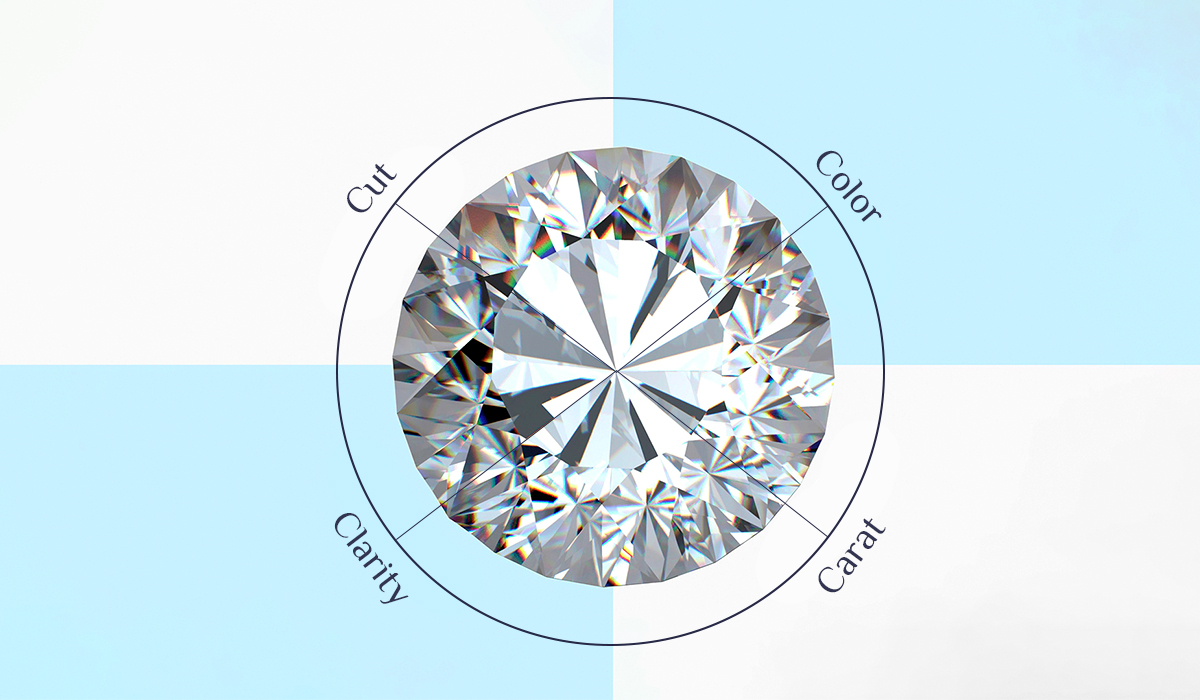
When it comes to purchasing a diamond, understanding the 4Cs—Cut, Color, Clarity, and Carat Weight—is essential. These criteria are the global standard for assessing the quality of diamonds, established by the Gemological Institute of America (GIA). Each aspect plays a crucial role in determining a diamond’s value and overall appearance.
1. The Importance of Cut
The cut of a diamond is perhaps the most critical factor among the 4Cs. It refers not to the shape of the diamond but to how well a diamond’s facets interact with light. The quality of the cut affects the diamond’s brilliance, fire, and scintillation.
Brilliance
Brilliance refers to the white light reflections from the surface and interior of a diamond. A well-cut diamond will exhibit a high level of brilliance, making it appear more radiant.
Fire
Fire describes the dispersion of light into the colors of the spectrum. A diamond with an excellent cut will show vivid flashes of color, enhancing its visual appeal.
Scintillation
Scintillation is the sparkle a diamond produces when moved under light. It is the combination of brilliance and fire, contributing to the overall attractiveness of the diamond.
Cut Grades
The GIA grades diamond cut quality as Excellent, what matters in the diamonds 4cs, Very Good, Good, Fair, and Poor. An Excellent cut grade maximizes the diamond’s potential for brilliance and fire, while a Poor cut grade results in a dull appearance, regardless of the diamond’s clarity and color.
2. Understanding Color
The color of a diamond is assessed based on the absence of color. The GIA’s color grading scale ranges from D (colorless) to Z (light yellow or brown). The less color a diamond has, the higher its value.
Colorless Diamonds
Diamonds graded D-F are considered colorless. These diamonds are extremely rare and command the highest prices due to their exceptional purity and rarity.
Near-Colorless Diamonds
Diamonds in the G-J range are classified as near-colorless. They offer a good balance of quality and value, as they appear colorless to the untrained eye and are more affordable than truly colorless diamonds.
Faint to Light Color Diamonds
Diamonds graded K-Z show increasing levels of color, from faint to light yellow or brown. These diamonds are generally less expensive and are often set in yellow gold to mask the tint.
3. Clarity: The Measure of Perfection
Clarity evaluates the presence of inclusions (internal characteristics) and blemishes (external characteristics) in a diamond. The fewer inclusions and blemishes, the higher the diamond’s clarity grade.
Clarity Grades
The GIA clarity scale includes the following grades:
- FL (Flawless): No inclusions or blemishes visible under 10x magnification.
- IF (Internally Flawless): No inclusions visible under 10x magnification.
- VVS1 and VVS2 (Very, Very Slightly Included): Inclusions are difficult to see under 10x magnification.
- VS1 and VS2 (Very Slightly Included): Inclusions are minor and range from difficult to somewhat easy to see under 10x magnification.
- SI1 and SI2 (Slightly Included): Inclusions are noticeable under 10x magnification.
- I1, I2, and I3 (Included): Inclusions are obvious under 10x magnification and may affect transparency and brilliance.
Impact on Appearance
Clarity significantly affects a diamond’s appearance and value. While FL and IF diamonds are extremely rare and highly valued, many inclusions in VS and SI grades are not visible to the naked eye, providing excellent value for money.
4. Carat Weight: Size Matters
Carat weight measures a diamond’s size. One carat equals 200 milligrams, and each carat is subdivided into 100 points. For example, a 0.75-carat diamond is the same as 75 points or three-quarters of a carat.
Understanding Carat Weight
Larger diamonds are rarer and thus more valuable. However, carat weight alone does not determine a diamond’s value. Two diamonds of the same carat weight can have vastly different values depending on their cut, color, and clarity.
Balancing Size and Quality
While larger diamonds have more visual impact, a smaller diamond with an excellent cut, high clarity, and color grade can be more brilliant and appealing than a larger, lower-quality diamond.
Combining the 4Cs for the Perfect Diamond
When choosing a diamond, consider how the 4Cs interact to affect the diamond’s overall beauty and value.
Prioritizing the Cut
Since cut has the most significant impact on a lab diamonds brilliance, prioritize the best cut you can afford. A well-cut diamond maximizes the stone’s light performance and can make a smaller diamond appear more significant.
Balancing Color and Clarity
Consider the setting of the diamond when choosing color and clarity. For example, a diamond with slight color may look whiter in a platinum setting, while yellow gold can mask slight tints. Likewise, clarity characteristics might be less noticeable in certain settings or shapes.
Making Informed Decisions
Understanding the interplay of the 4Cs helps in making informed decisions. Whether you prioritize carat weight or clarity, the key is to find a balance that suits your preferences and budget.
Conclusion
Mastering the 4Cs—Cut, Color, Clarity, and Carat Weight—is fundamental to selecting the perfect diamond. By appreciating how each factor affects a diamond’s overall beauty and value, you can make a confident, informed choice. Remember, the most beautiful diamond is the one that meets your individual preferences and budget, showcasing the timeless allure and elegance that only a diamond can offer.

